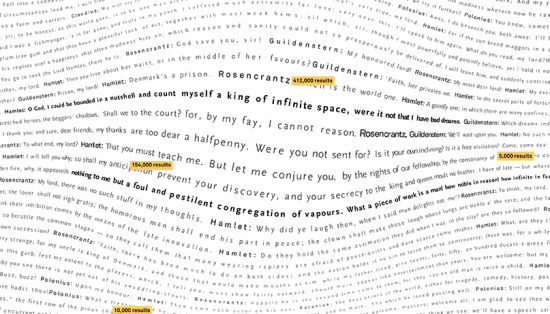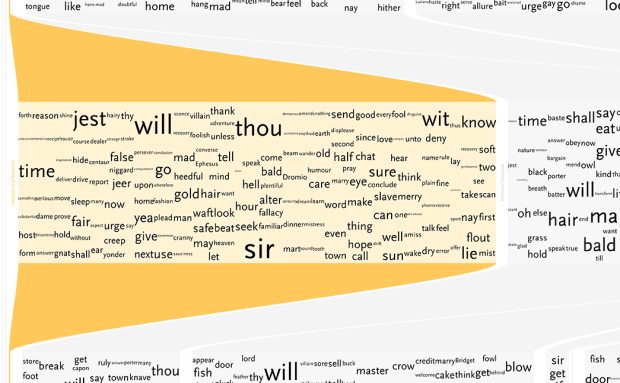Shakespeare literature is confusing. That’s not even an opinion. It’s a fact. Stephan Thiel, for his B.A. thesis at the University of Applied Sciences Potsdam, takes a wack at understanding Shakespeare through a series of visualizations.
As a result, and based on data from the WordHoard project of the Northwestern University, an application of computational tools was explored in order to extract and visualize the information found within the text and to reveal its underlying narrative algorithm. The five approaches presented here are the first step towards a dicussion of this potentionally new form of reading in an attempt to regain interest in the literary and cultural heritage of Shakespeare’s works among a general audience.
The above is a sample from an exploration of the most frequently used words for each character. The major characters’ speeches are highlighted in yellow.
My favorite experiment of the series, albeit, probably the least developed, is a view of Macbeth and Hamlet through the eyes of Google search results. In an effort to find significant quotes, phrases were queried and a force was applied to words based on the number of results returned. The end visual looks like a document with fisheye zooming in significant areas.

See the full visual series here.
[via]


 Visualize This: The FlowingData Guide to Design, Visualization, and Statistics (2nd Edition)
Visualize This: The FlowingData Guide to Design, Visualization, and Statistics (2nd Edition)

Less confusing? No, but cool.
Pingback: Understanding Shakespeare | VizWorld.com
I’m all for taking different perspectives on literature and art; but, to me, this doesn’t add anything to our understanding of Shakespeare. You’re better off reading, I think.
i think as a complement, and not as a substitute, it could be useful.
hi!
@nathan first of all, thanks for posting. really appreciate it! getting feedback on this is one the things I am very interested in now!
@jeff you’re absolutely right. when it comes to fully understand shakespeare there is nothing else you can do except reading the works. what I am trying to do is to provide a possibly new initial starting point for their discussion, because I see the problem that our today’s reading habits prevent more and more people from reading shakespeare ‘the original way’. the visualizations were ment to open new perspectives on the texts and to possibly reveal interesting insights or simply an overview that would otherwise require intensive reading. and hopefully, with this experience people will say »oh, that’s interesting, I have to read this!«
additionally some approaches really have the potential to reveal and communicate the way shakespeare works with language and the way he ‘crafted’ the characters. for instance, the summarization approach works – in my opinion – really well, because shakespeare uses words frequently in order to emphasize the important message within a monologue. of course, there won’t be a ‘golden formula’ to explain the way shakespeare worked — and this is good. but I do personally really like these glimpses into the universe of such an incredible artistic work.
Pingback: Teaching With Infographics | Places to Start - The Learning Network Blog - NYTimes.com
Pingback: Understanding Shakespeare with Visualization » TeachEng.us